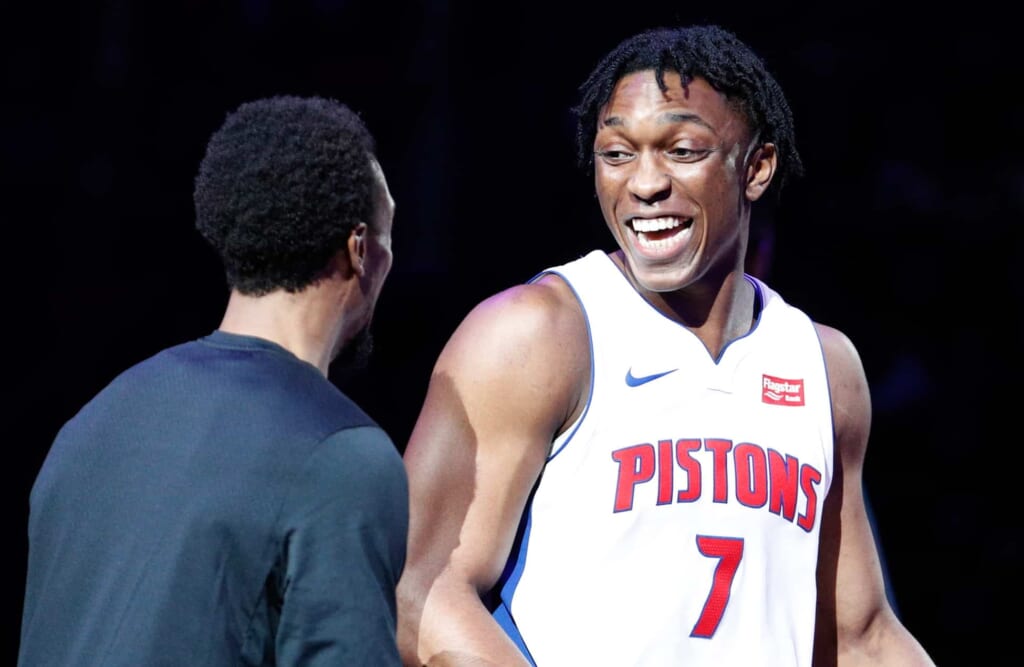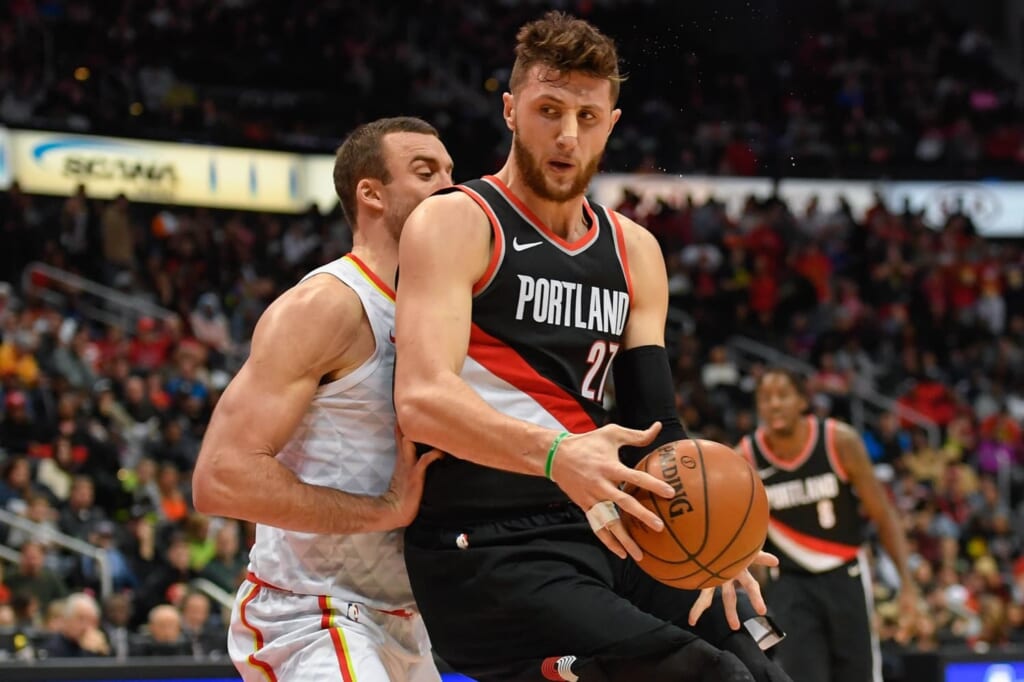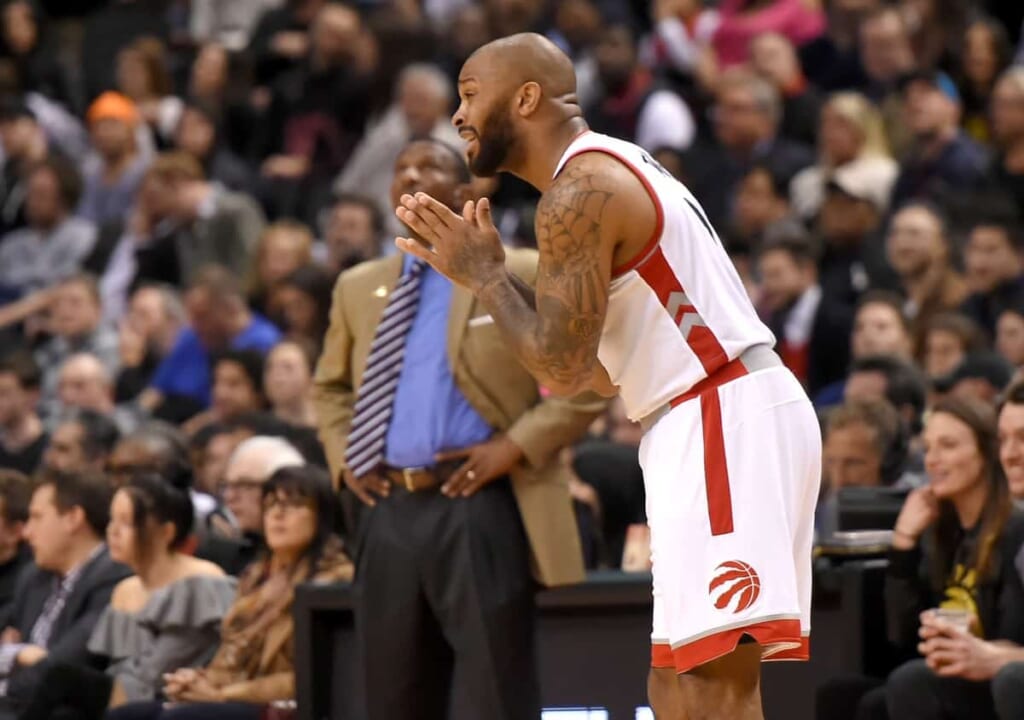
The NBA playoffs will soon be upon us. There are only 20 or so games (depending on the team) left in the regular season, and a whole lot still to be settled. After the dust clears, the only matter left will be the postseason. Simple, right?
This list will focus on the players who will, quietly, play a huge role in the coming weeks. Not the stars — you already know about them and nobody needs to be told that Kevin Durant and LeBron James will impact the title race. This is about the rotation players and bench pieces, the guys who become just a little more important in the playoffs and need to step up to the moment. Here are 14 X-factors that will help shape the NBA title race.
Delon Wright, Toronto Raptors

Here’s a stat: Delon Wright ranks 15th in point guards in real plus-minus, ahead of Eric Bledsoe, John Wall, Lonzo Ball and Ricky Rubio (among others). That’s not the end-all, be-all, but, uh, we should be talking about Delon Wright a little more. He’s shooting it efficiently, turning it over at a low rate and playing good defense at a position where Toronto needed someone to step up behind Kyle Lowry after Cory Joseph’s departure.
Wright is stroking it at 37.5 percent from three-point land and is the type of defender who can help push a team over the edge in the playoffs. He’s no Tony Allen, but the Raptors have been better with Wright on the court the past two years and that matters. He’ll see extended playoff minutes this year. What he does with them will make a big difference to the Raptors’ fortunes.
Larry Nance, Cleveland Cavaliers
Out of every Cleveland trade deadline acquisition, none has a chance to make a bigger impact than Nance. That’s not to say Nance is the best player the Cavs got — he may not be, at least in the short term — but the 25-year old is exactly the sort of player who can make a difference when it matters. Nance is a walking spark of energy off the bench. He averages only 8.6 points per game, but does so an impressive 19.6 PER.
Nance throws down flashy dunks like nobody’s business, but he also rebounds well for a small-ish ‘five’ and has all of the offensive qualities you want in such a player from an athleticism standpoint. (He doesn’t shoot well from three, but he also doesn’t take many shots from there.) His defense leaves something to be desired, which leaves the Cavs right where they started in one sense, but Nance’s play-style builds chemistry, which will help Cleveland in the long run, along with the fact that he’s pretty good at the whole basketball thing.
Cory Joseph, Indiana Pacers
Joseph’s numbers are down his first year in Indy. Not hugely, mind you, but enough that — together — it constitutes a two-point drag on his PER, bringing it to a somewhat alarming 11.2. He’s also 59th among point guards in real plus-minus, largely because of his defense. Joseph’s RPM was similarly bad last season, but it’s uncomfortable that his offensive output has clearly slid. His assist rate is 16.3 percent, which would be a career-low if the season ended right now, as would his .170 free throw rate.
The Pacers — once golden in the Eastern Conference — are only a couple games up in their fifth-seed perch. Despite a better-than-expected season from Darren Collison, their point guard situation leaves something to be desired, and a return to form from Joseph would help mitigate that.
Tony Snell, Milwaukee Bucks
Once the ire of Bulls fans, Snell has done an impressive job carving out a role for himself with the Bucks. That’s in large part due to a surge in three-point shooting last season, but it’s carried over into this year. Heck, it’s even gotten a tick better — Snell is hitting at 41.1 percent from beyond the arc right now. He’s one of the league’s better three-and-D wings right now. His length works in Milwaukee, even after Joe Prunty scrapped Jason Kidd’s “everyone trap everything then scramble as fast as you can to recover” system on defense.
Snell has a low offensive output and his 8.6 PER won’t be mistaken for anything else. He’s not a good passer or rebounder and has to stay within a pretty narrow three-and-D role to stay effective. But there’s also no reason why that can’t work. Milwaukee is better with him on the floor this season, a trend that carried over from last year’s playoffs. If it holds, the Bucks could make some noise.
Stanley Johnson, Detroit Pistons

Johnson is similar to Snell, with one stipulation: he shoots an atrocious 29.2 percent from distance. The 21-year old can try to make up for it with decent enough rebounding and assist numbers — at least for a wing — but he tends to consistently prove just how important three-point shooting is today. Johnson is at the point where teams can ignore him from beyond the arc even in the regular season. Let’s be clear: this isn’t something that’s going to get by April, or maybe even ever (and the Pistons might not have playoff games in which to complain about his poor shooting).
But figuring out a way to get around it is pivotal to Detroit’s chances of making the postseason. Johnson has shot more threes this year, which has an illusionary effect on some defenses, but that will only go so far. He needs to become a more avid cutter — something he’s barely doing right now — and start to punish defenders that stop paying attention and turn their heads. The Pistons’ spacing is already cramped with Blake Griffin and Andre Drummond. Lineups featuring those two with Johnson have slayed in a limited sample size (161 minutes). They would get even better if Johnson could start finding ways to punish teams for ignoring him on offense.
Bam Adebayo, Miami Heat
Adebayo has quietly done some really nice things in his rookie year. The per-game stats don’t stand out, but Adebayo’s PER is a solid 16.9 and his defense has been solid, especially for a rookie. He’s a solid rim protector (though not near the level of teammate Hassan Whiteside) and pulls down 9.3 boards per 36 minutes. Adebayo is a little awkward with the ball in his hands, but he can finish pick-and-rolls as well. The Heat can get away with playing him in the postseason (if they get there), but keeping up this level of play won’t be easy for the rookie. It’ll be fun to see if he can.
Tyus Jones, Minnesota Timberwolves
T-Wolves Twitter has been heavy on the ‘Play Jones more’ bandwagon. They’re not entirely wrong. Jones is a minus defender — that will hurt Minnesota in the playoffs — but he can do some things with the ball in his hands. Jones is in the 70th percentile as a pick-and-roll ball handler, per NBA.com, and has seen steady shooting improvemennts throughout his career. Though his assist rate is down, Jones is also a capable passer. At age 21, it’s an impressive resume for a late first-rounder who was an afterthought his first year in Minnesota. Defense is likely the reason Jones isn’t playing more and it’s unlikely we see a major shift there before the playoffs. But Jones can make a difference for Minnesota when he’s out there.
Terrance Ferguson, Oklahoma City Thunder
Whether or not Ferguson can adequately replace Andre Roberson will have a huge impact on Oklahoma City’s playoff viability. The rookie isn’t a good three-point shooter, but neither is the guy he has to replace, so let’s look past that and focus on everything else, none of which is especially promising. Ferguson is simply not a good defender right now — a problem that has as much to do with his being 19 years old than anything else, but a problem nonetheless. And though we can overlook shooting poorly from distance, it’s a problem that Ferguson is taking 5.6 threes per 36 minutes when he can’t make any of them. Right now, Ferguson’s PER is a horrific 5.9 and he’s starting on a playoff team. The Thunder — a team solidly in the playoffs — have a -7.0 net rating with Ferguson on the court. If that holds into the postseason, well, yikes.
Will Barton, Denver Nuggets
Barton is quietly one of the more important cogs in Denver’s offense. Coming off the bench, Barton is putting up good scoring numbers with fairly efficient shootinng. His assist rate is also at 19 percent — a career-high and an impressive number for a wing who’s never been thought of as a passer. However, his defense leaves a lot to be desired. The Nuggets are worse with him on the court despite scoring at a higher clip. Denver’s defense is bad in general, of course, so picking on Barton alone is a bit unfair. However, he’s also just as much at fault as anyone else. If the Nuggets want to compete in the postseason (should they make it), tightening some loose screws onn that end is vital. Barton is one of them.
Jusuf Nurkic, Portland Trail Blazers

Nurkic went on a rampage after being shipped to Portland last season, butting up perhaps the best 20 games of his career. He’s rebounded some this year, but a 17.5 PER on 19.1 points and 11.2 rebounds per 36 with good defense ain’t nothing to sneeze at. It’s easy to overlook Nurkic when Portland’s backcourt features Damian Lillard and C.J. McCollum, but the Bosnian is pretty good at what he does. His touch outside of three feet leaves something to be desired, but Nurkic is a good defender. He can make a difference in the playoffs against the right opponent. If Portland avoids Golden State or Houston in Round 1, Nurkic will be a huge factor as to whether it moves on.
Jae Crowder, Utah Jazz
If Utah gets the Boston version of Jae Crowder, the Jazz are going to make the playoffs. Remember that guy? He shot 39.8 percent from 3 last season, played solid defense, pulled down nearly six boards per game, and tried hard. After being shipped to Cleveland, that version of Crowder evaporated. He became another cog in a machine that wouldn’t work. Crowder’s three-point percentage dropped to 32.8, his rebounding plummeted and his defensive prowess evaporated. That was an untenable situation though. Utah can get the old version of Crowder. They have better chemistry than the Cavs did (along with 28 other teams) and Quin Snyder usually gets the best out of his players. If he’s at his best, Crowder can make up for Rodney Hood’s departure and more.
P.J. Tucker, Houston Rockets

As far as peripheral players go in Houston, Tucker is about as important as it gets. He supplanted Ryan Anderson in the starting lineup just before the All-Star break — an acknowledgement that the Rockets won’t get by with Anderson plodding in pick-and-roll defense in the postseason. They need a veteran like Tucker, who built his career on hard-nosed defense. Tucker made a difference in Toronto last year after being shipped north of the boarder at the deadline. He’s done the same in Houston — the Rockets have a 103.6 defensive rating with him on the court. Tucker is also a good enough three-point shooter to play in Mike D’Antoni’s spread pick-and-roll system without any trouble on the offensive end. He might be the most important non-future Hall of Famer to the Rockets’ success — it’s either Tucker or Clint Capela. If and when the Rockets need a stop against Golden State in the playoffs, Tucker is the man they’ll turn to.
E’Twaun Moore, New Orleans Pelicans
New Orleans’ depth leaves a lot to be desired. Moore is a fine player, but asking him to start on a team that wants to be in the playoffs is a lot. However, he’s performed admirably given the situation. The 28-year old is hitting 43.3 percent from 3 — a career-high — and has an impressive 59.4 effective field goal percentage. We always knew Moore was a solid offensive player, though he has outperformed expectations. However, his defense has not. Moore is 83rd among shooting guards in defensive real plus-minus almost entirely due to defensive struggles. The Pelicans are coughing up a 107.5 defensive rating with him on the court, which just isn’t good enough given the minutes Moore plays. Now that DeMarcus Cousins is gone for the year, everyone else has to step up if New Orleans is going to stay in the playoff hunt. Moore is chief among them.
Tobias Harris, Los Angeles Clippers
After trading Blake Griffin, it looked like the Clippers would turn around and tank. Instead, they held onto DeAndre Jordan and Lou Williams, even giving the latter an extension, choosing to go with them, plus the talent they got back from Detroit, and make a playoff push. If that plan has a chance of succeeding, Harris has to be at his best. The 25-year old is having a career year on offense — he’s shooting 40.2 percent from three and scoring 18 points per game. He’s 10th among small forwards in real plus-minus (really, he should be listed as a power forward, but the point stands) and though his defense leaves room for improvement, Harris still has intriguing upside. He seems to be starting to realize it as well. That has to continue if the Clippers are to succeed.
Note: Stats current as of Thursday, February 22